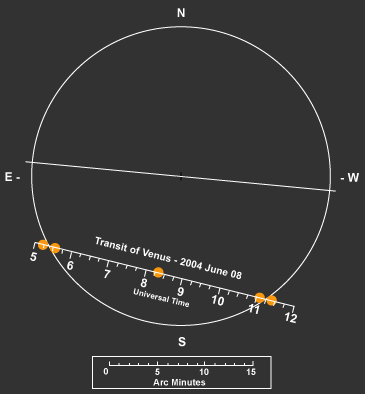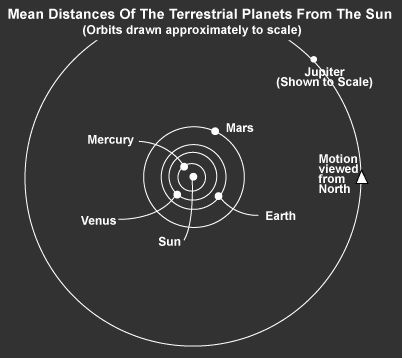What is . . the transit of venus ?
The Transit of Venus The Sun Venus
What is a transit of venus?
- Definition :: transit
- An act, process, or instance of passing through or over; the conveyance of something from one place to another
There are nine planets in our Solar System which journey around the Sun (note that the image below is not to scale). The order is : sun, mercury, venus, earth, mars, jupiter, saturn, uranus, neptune, pluto. 
Venus is the second planet from the Sun while we live on the third planet, Earth.
On 8th June 2004 a transit of venus will be observed from Earth when Venus comes directly between the Sun and our planet and it will be seen to move across the bright solar disk.

What will I see?

Viewed from Earth, Venus will appear as a black dot moving slowly from left to right across the southernmost part of the Sun’s bright disk. With a diameter of approximately 12, 103 km, 114 Venus sized circles could fit across the full width of the Sun.
One aspect to watch out for is the famous “black drop” effect which can be observed just as the planet proceeds fully onto the solar disk. This is due to the fact that light from the Sun is bent around the planet (refracted by the atmosphere of Venus). So at the edge of the Sun (the solar limb),Venus appears to be slightly “larger”, giving the optical illusion of a stretched out black drop.
How long will it last?
Well that depends where you are in the world! Not everyone on Earth will be able to view the transit. NASA has produced a world map indicating what countries will be in the path of the transit. Also, NASA has provided information on the start and end times of the event for many major cities across the world.
As an example, take the location where Jeremiah Horrocks first predicted and observed a transit of Venus on 1639 – that is Much Hoole, near Preston, Lancashire, United Kingdom. The transit will start at 06:19am and end at 12:23pm having lasted for just over 6 hours.
How can I observe it safely?
All observations that involve looking at the Sun are dangerous. Precautions must be taken to avoid permanent eye damage. If you are planning to observe the transit of Venus in June 2004 then
NEVER LOOK DIRECTLY AT THE SUN WITH THE UNPROTECTED EYE – THIS CAN CAUSE BLINDNESSWITHIN SECONDS.
NEVER OBSERVE THE SUN DIRECTLY THROUGH A TELESCOPE OR BINOCULARS WITHOUT PROPER OPTICAL FILTERS FITTED TO PROTECT YOUR EYES.
Follow the simple rules on this website so that you can enjoy being part of this rare astronomical event in safety.
After June 2004, when is the next transit of Venus?
You do not have to wait too long as the next transit of Venus is in 8 years time (6th June 2012). However, after that there will not be another one in your lifetime.
Occurrences of Transits of Venus follow an unusual pattern. The last one was in 1882, a gap of 121 years until the event in 2004. Then in 2012, Venus will be in transit again (8 years later). However, we are going to have to wait 105 years until the next transit of Venus in 2117, then 2125 and then 2247!
The reason for this strange behaviour is that the journey of Venus around the Sun (its orbit) is slightly at an angle (or inclined) to the path that the Earth makes around the Sun. For that reason, we do not see a transit of Venus every time in 1.6 years that Venus comes between the Sun and the Earth.
|
